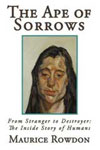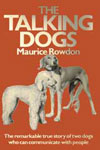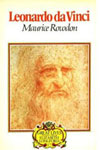Human/Animal Intelligence
From the time he began his first explorations into oriental thought Maurice’s personal and professional life changed radically. He began to devote more and more of his time to an intense personal exploration of the nature of human and animal intelligence, most especially the human’s collective vision of himself – his mythologies and ‘histories’.
He was commissioned to write Elke and Belham, The Talking Dogs, a book about two dogs in Germany, a saluki and a standard poodle, and this had him embark on his studies of the human as an animal. These dogs communicated with their teacher by tapping into her hand a given number of times for each letter in the German alphabet. He witnessed many sessions over a period of months, with occasional visits from Paris Match to take photographs.
With the publishing of his Elke and Belham, The Talking Dogs, he ceased accepting commissions and focused entirely on his Oxygenetic breathing process which laid the basis for his future writing. Through working with hundreds of clients Maurice came to feel that the human suffers from eroded faculties which compromise his natural intelligence and that this erosion has given us our present world in which the planet, other species and our own are under dire threat from our human activity. His last book, The Ape of Sorrows, From Stranger to Destroyer: The Inside Story of Humans was the culmination of fifteen years of dedicated thought on this subject. It was completed in the months before his death in February 2009. www.theapeofsorrows.com
The Ape of Sorrows – From Stranger to Destroyer: The Inside story of Humans

iUniverse – 2009
A book drawn not from the human’s stories about himself, least of all his histories, but from his far more spectacular, far more ardent and painstaking mutations and adaptations.
Reviews
Notes: What he wrote about it to his agent, Arthur Orrmont, Author Aid Associates, NY in 1994: ‘I am enclosing thoughts about the MAD APE (now, The Ape of Sorrows) theme. They aren’t part of any new draft of the book because I’m not going to write one…They are just jotted down for you and you alone, as the probably basis of what I would do by way of pointing up, getting the corners and indicators right. It seems quite absurd that such a theme, which every day is getting more and more evidence for its truth, should submerge in a sea of argument. I want perfectly simple sentences like ‘What are we going to do about this? Can we do anything? What do we mean by ‘doing’?
Excerpt
‘ …one key question which has rarely been seriously broached, namely what is human? We can’t say that he is just another primate because he isn’t. But his differences don’t lie in matters of eye socket and frontal lobe. ’
Excerpt
Of all the words in modern vocabularies one dominates and that is enemy. I am going to adapt something Freud said about phobia: the wonder isn't that we are enemy-fixated but that we are ever anything else! The enemy is the one who always stands in our light. Get him out of the way and the light shines on us. Actually, we invent him. After all, no creature is born with this name. But fiction or no fiction we must get rid of him in order to see the light. [Download PDF more...]
to top >The Talking Dogs or Elke and Belham

MacMillan 1978
Putnam NY 1978
Reviews
Excerpt
‘When I met Elke 11, the standard poodle bitch, and Belam, the saluki male, on a hot September afternoon in 1975 at Salzburg airport, they were sitting leashed at the entrance with their teacher, too shy at first to offer me their paws in greeting. Elke’s white fur was dazzling in the remarkably clear, mountain-reflected sunlight, her eyes round and black and vivaciously attentive as she sat waiting rather stiffly for my arrival. At her side, Belam, taller and bonier, seemed the shyer of the two, with his long sensitive nose and gazelle-eyes, and deliciously straggling fur. He simply gazed away when I bent down to take Elke’s paw. But at a word from his teacher he too shook hands.’ [Download PDF more... ]
to top >Leonardo da Vinci

Weidenfeld and Nicolson – 1975
Under construction
